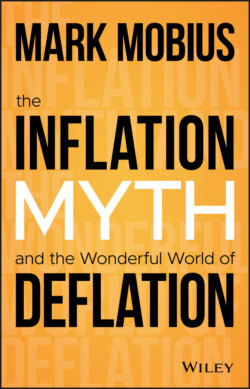Читать книгу The Inflation Myth and the Wonderful World of Deflation - Mark Mobius - Страница 6
PREFACE
ОглавлениеShortly after this manuscript was handed into my publishers in early 2020, the COVID‐19 outbreak shook the world and changed life as we knew it. From one day to the next, hundreds of thousands of lives were at stake and our economic systems came to a halt as governments around the world entered into unprecedented shutdowns.
In the wake of the COVID‐19 crisis, we witnessed a lot of speculation about global economies slipping into recession. This, in turn, was expected to lead to a deflationary environment driven by weakening growth and demand. As a result of the crisis, we witnessed short‐term price fluctuations in stock and bond markets all over the world.
However, the argument of this book is focused on the longer term trends regarding the rise and fall of economies and market.
I believe we have been putting too much weight on inflation statistics which are for a variety of reasons faulty. Despite economic slowdowns – caused by various crises over the years – advances in technology and automation are leading to continuously falling costs for goods and services. At the same time, a wave of completely new products enters the consumer stage every year, improving lives around the world. On example of how technology is reducing costs is the conference call service provided by Zoom Communications; users of their conference app dramatically increased from 10 million per day in December of 2019 to 300 million per day by April 2020. Many of these new users were using the free Zoom version, as opposed to the premium one, so paying nothing for a service that would have cost hundreds if not thousands of dollars in telephone bills just 10 or 20 years previously. To accurately depict this phenomenon of constant technological innovation in inflation statistics is at best challenging, if not impossible, as this book will show.
Another argument of this book is that the “basket” of goods and services which forms the basis of the CPI (Consumer Price Index) calculation is continuously changing, so the basket of 1900 is different from the one in 1950, and the one in 1950 is different from the one in 2000. The problem is that you are comparing different baskets of goods and services, thus rendering any comparison somewhat meaningless. Furthermore, with consumption patterns constantly changing, the basket is always a step behind when it comes to tracking “typical” spending patterns.
Over the years we have seen far‐reaching changes in the way people work, shop, and spend their time. This in turn has led to significant changes in spending patterns and, in some cases, rapid price changes. Certain goods have disappeared from shelves and many services are no longer provided. So, calculations based on the “old” basket no longer reflect changes in the consumer welfare of a “typical” person, as typical consumer behavior has changed.
If inflation statistics do not accurately reflect the changes in peoples' welfare, then it does not make sense to stick to inflation targets. By 2020, central banks were learning this the hard way as their financial tools were proving less and less effective in influencing inflation numbers. What we need to recognize is the necessity of questioning the holy grail of inflation targeting and rethinking an approach that we have been following almost blindly for a long time.
This book aims to help unravel the Myth of Inflation and to provide some food for thought on the future of the inflation policies that are significantly impacting our everyday lives around the world. More importantly I want to demonstrate that, in fact, we are in a deflationary world with goods and services improving in quality and variety while declining as a percent of people's incomes.
